American
Horse (1840-1908) was a rising young leader among
the Loafer Band of Oglala at the Red Cloud Agency during
1876 and was not with the northern or "hostile"
Oglala. In fact, it was his cooperation with the U.S.
Army in disarming the hostiles as they came in to Red
Cloud that earned him government support. The Loafers
at Red Cloud were originally under the leadership of Blue
Horse (brother of Big Mouth
shot by Spotted Tail
at the Whetstone Agency). With the rise of American Horse's
prominence among the Loafers during the Sioux War of 1876-77,
as well as the rise of another Oglala named Three
Bears, Blue Horse's leadership was largely
eclipsed. By the time the Oglala moved to the Pine Ridge
Agency in 1878, the Loafer's split into three separate
bands, including one under American Horse.
During
the 1870's, there were several Lakota and Northern Cheyenne
named American Horse. George Hyde was incorrect in referring
to the Oglala by this name as American Horse (the Younger)
and the individual killed at Slim Buttes as American Horse
(the elder). They were not related; nor were they ever referred
to this way by their own people. Unfortunately, historians
have continued to contribute to this confusion since 1876!
The
Oglala American Horse (1840-1908) did participate as a young
Bad Face warrior in Red Cloud's war in
the late 1860's. In fact, later in life, he claimed to have
personally killed Lieut. Fetterman and his war club which
he used is now on exhibit at Agate Fossil Beds National
Monument. He was made a "shirt wearer" along with
Crazy Horse,
Sword, and Young Man Afraid of
His Horses. However, by the 1870s, American Horse
was a rising young leader among the progressive band, the
Wagluhe or Loafers (probably by marriage) and no
longer fighting the whites. Your brief summary of the man
killed at Slim Buttes is a mixture of several different
people.
The
original source for the man's name killed at Slim Buttes
was scout Frank Grouard. However, natives present at the
battle say that Grouard was incorrect, that the man's name
was Iron Plume and that he was not a prominent
leader; rather, he is described as a brave individual. We
actually know virtually nothing about his background.
He
Dog: "I was in Slim Buttes fight. . .
. The tribe massacred there were Minneconjou, who were out
deer hunting. No chief was killed here. The man wounded
in bowels and died here was not a chief. He was a Sans Arc
relative of mine." (Camp Interview)
American
Horse (Oglala), when asked about the man killed at Slim
Buttes: "There are only two American Horses and both
are living, himself being one. The other lives below the
battlefield on Wounded Knee and is a brother to Woman's
Dress. He says there was never an American Horse
killed." (Ricker Interview)
There
was a headman among the Two Kettle Lakota named American
Horse (born about 1836) who according to records at the
Cheyenne River Agency left there on May 21, 1877. Apparently
not at Little Bighorn.
There
was also a Northern Cheyenne named American Horse who later
surrendered at the Red Cloud Agency and was transferred
to Indian Territory with other Cheyennes in May 1877.
I
think for the list of Little Bighorn participants, there
should be an entry for Iron Plume, though we are not certain
that he was actually at Little Bighorn. A number of Minneconjou
and Sans Arcs fled from the Cheyenne River Agency in the
fall of 1876 when the military was preparing to disarm them
and remove their ponies. There were many of these kinds
of people in the Roman Nose
village at Slim Buttes in September 1876. That does not
necessarily mean they were at the Little Bighorn as well.
Anyway,
I just wanted to help try to clarify the confusion about
the several individuals named American Horse and to contribute
that the Oglala individual by this name was NOT at the Little
Big Horn.
In
the Eleanor Hinman interviews, He Dog's brother Short
Bull said the following about the issue of American
Horse versus Iron Plume:
"Our
next fight was the Slim Buttes fight... [Here the interpreter,
John Colhoff, put in a word, saying that he had read in
a book that the chief American Horse was mortally wounded
and taken prisoner in this battle; but that was a mistake.
American Horse was not taken prisoner in this battle; neither
did he die of wounds received there. Short Buffalo
confirmed the younger man in this. Asked who the man was
who was shot through the intestines while concealed in the
sand-pit, and who died that night and was left for the Indians
to bury, Short Buffalo replied:]
"Iron
Plume was the man shot in the sand pit. There were women
in that pit too. Iron Plume didn't give up until he was
too badly wounded to live. It was Iron Plume, not American
Horse..." —
Ephriam Dickson
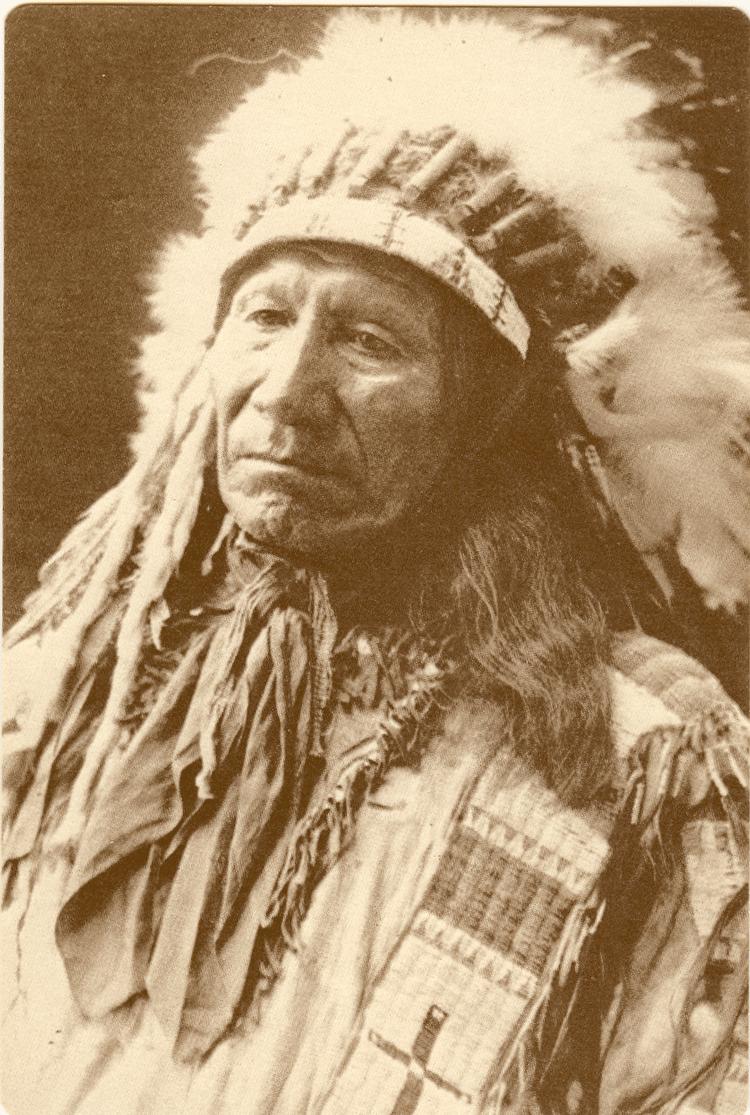
—
Charlie
I
know some books which mention American Horse married to
Red Cloud´s daughter, but they all seem to cite the
Ricker interviews. If my sources are correct, American Horse's
winter-count was begun by his grandfather in 1775/76 and
later was continued by his father Sitting Bear.
Army surgeon Dr. William H. Corbousier collected several
winter-counts from November 1879 to April 1880 (American
Horse, Cloud Shield, White Cow
Killer) at Pine Ridge Reservation. I assume this
is the reason why all of these winter-counts ended around
the year 1879/89.
Several
books rate American Horse as a Southern Oglala. Richard
Hardorff is one of these authors. According to him American
Horse, nicknamed Spider, succeeded his father as band leader
of the True Oglalas and was elected shirt-wearer in 1868.
Further he said that American Horse married Red Cloud's
daughter and joined latter in 1871 to become a reservation
band chief.
Interestingly Sitting Bear in his younger days was also
named American Horse. Hardorff made another statement about
the second American Horse, who was a leader of a “wild band”
of Northern Oglalas. He was a son of Old Smoke.
Neither he nor the other American Horse were at Slim Buttes.
Catherine Price wrote that True Oglalas who once followed
the Itancan Bad Wound later chose Sitting Bear and American
Horse as their leaders.
American
Horse with his wife/one of his wives. . . .
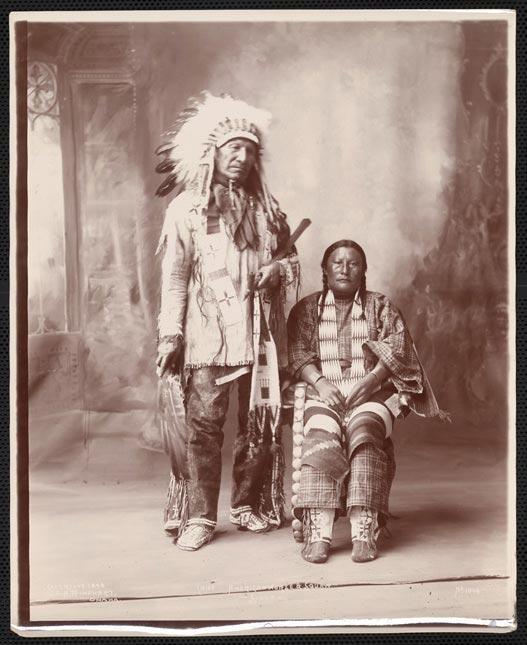
— Dietmar Schulte-Möhring
If
we have to give credit to C.Eastman's statements in "Indian
Heroes and Great Chieftains", American Horse's father
(which would have been Sitting Bear - we know his name thanks
to the winter count's entry of the year 1839-40 "Sitting-Bear,
American Horse's father, and others, stole two hundred horses
from the Flatheads") "was killed in battle while
he was still very young". Eastman goes on stating that
"The American Horse band was closely attached to a
trading post, and its members in consequence were inclined
to be friendly with the whites, a policy closely adhered
to by their leader." (a description which would fit
the Wagluhe band). Eastman was well acquainted with American
Horse, which would make him a reliable source, but then
he falls into inconsistencies as identifying the warrior
killed at Slim Buttes (Iron Plume) with someone sharing
American Horse's name and being his uncle.
Interestingly
enough, in the Ricker interview American Horse stated that
there was only another American Horse other than him, and
that it was Woman's Dress' brother (which would make him
the grandson of Chief Smoke), while "there was never
an American Horse killed".
About
the notion of American Horse being married to Red Cloud's
daughter: here's the comment about the following image recently
sold at an auction:
"American
Horse, married to a daughter of the war chief Red Cloud,
was a chief of the Bad Face (Ite Sica) band of
Oglala, later called the Loafer (Wagluhe) band.
He was also elevated to the position of an Ongloge Un
or Shirt Wearer, one of the four leading chiefs of the Oglala.
The deerskin garment which signaled this honor, trimmed
with beaded bands and locks of human hair, is displayed
atop the posing stand at left... American Horse died Dec.
16, 1908, at the age of 68."
Here's
the image:
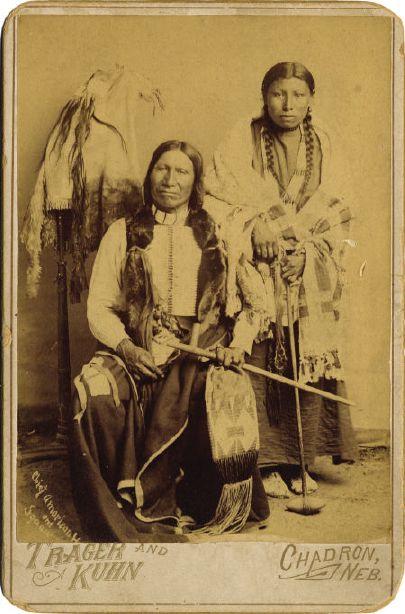
Another
picture that would confirm the existence of a family connection
between American Horse and Red Cloud is the one below, where
American Horse poses with some members of his family:
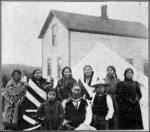
The
house on the background is clearly Red Cloud's (it was the
only 2 story house at Pine Ridge in those days). Why would
American Horse pose in front of Red Cloud's house if there
wasn't any family connection between them?
Thanks
for the information about "Sioux Jim" being Little
Big Man's brother. I suppose there's no way
to find out what was the guy's real name. . . . On the other
hand, American Horse's descendants might know something
about the original winter count and if there had been other
entries following the 1878 one.
I'm
inclined to think that the young woman is actually American
Horse's wife, as the customary use at the time was to have
husband and wife or a whole family's pictures. For example,
Red Cloud, the most photographed Indian of his times, was
never portraited with any of his daughters (while there
are shots of him together with his wife and his son Jack);
Geronimo was photographed with both his
daughter and his niece, but not with just his daughter.In
other words, it seems to me that the ideal pair for such
portraits was husband and wife.
I
agree that the woman in the picture looks much more younger
than American Horse, but taking young wives wasn't unusual
for Indians. I remember reading somewhere that He Dog took
a young wife when he was in his 70s - will check it in the
next days.
Here's
the pic of one of American Horse's daughters:
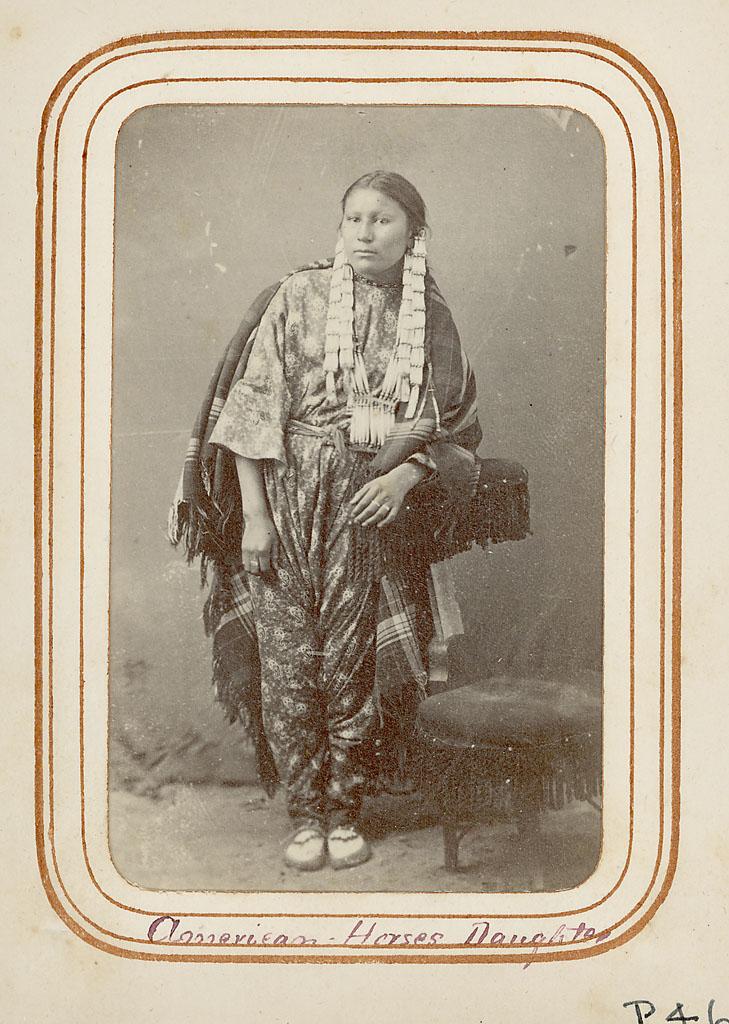
And
here's a link to an article appeared on the New York Times' March 1st 1880 issue, in which a picture of
American Horse together with his wife and daughter (but
not with his daughter alone!) is mentioned.
—
jinlian

American
Horse's daughter in the Godkin photo looks pretty much like
the wife (the inscription says squaw) in the Trager picture.
I would say they are the same person. Trager and Kuhn photos
are not known to be very accurate relating to identifications.
— Dietmar Schulte-Möhring

I've
managed to post a higher resolution copy of the Trager and
Kuhn picture. The Smithsonian (Godkin) picture of American
Horse's 'daughters was taken in the late 70s, while the
other one is dated 1883 and it's surely early 80s (from
American Horse's looks). The woman in the Trager and Kuhn
picture nevertheless looks almost younger than the other
one.
The
girl in the Smithsonian picture looks like Maggie
Stands Looking, one of the first girls sent to
the famous (or infamous) Carlisle Boarding School. Here's
a picture of father and daughter together with teachers
and other Indian students a Carlisle - the girl is obviously
the Godkin one and doesn't look like the wife(?) portraited
in the Trager and Kuhn cabinet card.
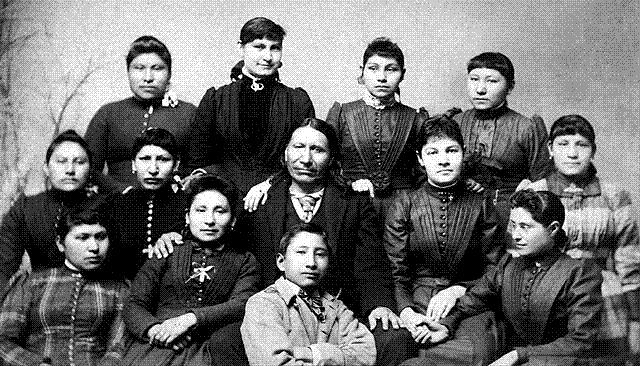
—
jinlian
According
to Mike Stevens´ genealogy website, American Horse
married his wife Sleep after 1862. She
still was his wife in 1904 when they were counted for the
Pine Ridge Census Records. After 1882 he married Josie
(born 1864). I don't know if he had other wives. The list
of his children doesn't seem complete either on that website,
hence Maggie is not listed.
— Dietmar Schulte-Möhring

Stevens's
genealogy, being based only on census and not on oral family
records sometimes isn't complete and the records are not
so accurate. . . . For instance, it doesn't list among American
Horse's children neither Robert American Horse
(obiously following Eastman, who has Robert as American
Horse's nephew while on Carlisle's records he's definitely
his son) nor Maggie Stands Looking, who's mentioned several
times as American Horse's daughter in Pratt's records and
other Carlisle related documents. —
jinlian

According
to American Horse's children as recorded in his army pension
file (thanks to Tom Powers who brought this to our attention),
he had five wives:
1.
Red Spotted Calf, also known as Spotted Elk Woman,
who he married in 1868. She died in 1889.
2.
Sleep, whom he married in the fall of 1871 at the first
Red Cloud Agency.
3.
Josie, a sister of Sleep, whom he married about 1886. Following
American Horse's death, Josie married Whirlwind Horse.
4.
Goes Out Looking whom he married in 1888.
They separated in 1889. His son recalled that they lived
together for only eight or ten days before they separated.
5.
Hard Woman, married in 1889 and separated in 1890.
When
American Horse died in 1908, he was still married to Sleep
and Josie.
As
for "Sioux Jim", the comment that he was a brother
of Little Big Man is from William Jordan, son of Charles
P. Jordan (clerk at the Red Cloud Agency in 1876-77; later
Indian trader on the Rosebud Reservation). William Jordan
and George Colholff are the sources for the fact that American
Horse lost his scalp shirt over the killing of Sioux Jim.
The only other name that I am aware of for Sioux Jim is
Fish Guts (probably Iyuhota Hogan).
As
to American Horse's original band ("band of birth"),
I am not 100% percent certain. We do know that his family
originally came from among the Southern Oglala, the Kiyaksa,
but as to which band within the Kiyaksa I do not
know. As mentioned above, he became a headman among the
Wagluhe (Loafers) during the 1870s. By 1890, he
was a headman in the Iyasica, a band associated
with the Hokayuta. —
Ephriam Dickson

I
guess we may speculate that if the notes in Ricker's book
are accurate, and American Horse actually married one of
the daughters of Red Cloud, that should have been Red Spotted
Calf, since in those years American Horse was associated
with the Ite Sica (in Ricker's interview American
Horse reported many of Red Cloud's war exploits, including
an assault to an emigrant wagon train they planned and carried
on together). But this is mere speculation.
Incidentally,
I've found the American Horse family picture on the Oglala
Lakota College website:
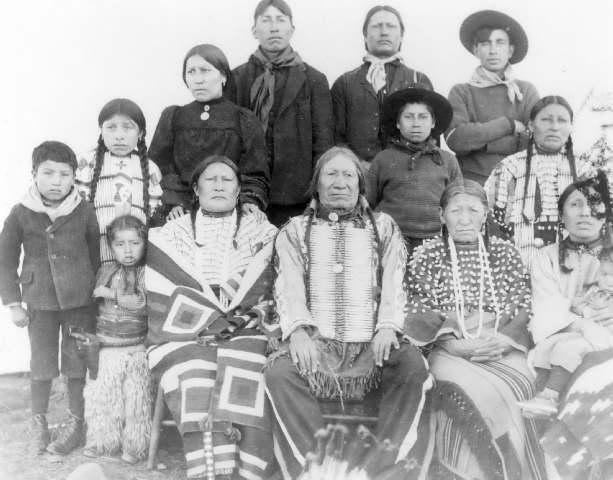
— jinlian
I
still tend to believe the woman in the Trager photo is more
likely his daughter than his wife. But if she is, she can
only be Hard Woman, I guess. Trager made most of his photographs
around 1890, so there is a possibility that she was pictured
with him. — Dietmar Schulte-Möhring

I've
checked Goodyear's book on Red Cloud and it's clearly stated
that Trager and Kuhn opened their studio in Chadron in the
summer of 1889.
And yes, if we assume that the woman in the picture is American
Horse's wife, the strongest possibility is that she's the
fifth one.
Now,
after checking "Plains Indian History and Culture"
(which quotes the Report and Historical Collections of the
South Dakota State Historical Society, I'm more and more
confused about Sleep and Josie being both married to American
Horse at the time of his death, since it reports that:
"When
the missionaries told Sioux Chief American Horse that Christians
had but one wife, he replied: "I took my wives according
to the custom of my people. They have been with me in my
joy and in my sorrow; they are the mothers of my children.
They are now old and I cannot throw any of them away but
if the time ever comes when I have but one wife, I will
join your church". That time did come. American Horse
joined the Episcopal church and was buried in its mission
cemetery" —
jinlian

A
good Lakota man always had many wives. A Lakota woman always
married at 14 to 15 years old. If a man was known as a warrior
he had many wives. We know that the govenment demanded the
men to give up their wives so many just did not report them
on the census. — Ladonna
Brave Bull Allard

Yes,
having more than one wife was indeed a sort of status symbol.
Regarding the government pressure on Natives to persuade
them to adopt monogamous households, the attempt of applying
the Edmunds Act (originally devised for Utah and Mormons)
in Indian Reservations, in 1895 led to to the arrest of
many people on charge of bigamy both in Pine Ridge and Rosebud.
American Horse was one of the most prominent victims of
this measure and his arrest made quite a sensation (even
the New York Times published reports as "American
Horse is arrested" and "The over-married red men".
It was probably hard to accept a "progressive"
"friendly Indian" (as American Horse was considered)
living in polygamy.
— jinlian

Interesting
that there are two stories as to why American Horse killed
Sioux Jim. One, because the latter was a) some kind of Indian
outlaw and b) going to leave the reservation to join the
non-treaty bands and roamers; therefore American Horse was
doing both Indians and whites a tremendous favour b) American
Horse was secretly passing rations to the northern bands
and Sioux Jim ratted on him! —
Grahame Wood

According
to information I found at Ancestry.com,
Sitting Bear's wife, American Horse's mother, was called
Walks With.
American Horse later took the christian name Matthew. American
Horse married Fannie Hard Woman in 1879. She was born in
1855. They had two daughters, Lucy (born
1880) and Alice Vina (born 1882). —
Dietmar Schulte-Möhring

Here
are some early notices of American Horse (1840-1908) that
go some way to identifying his band affiliations.
Early
notices do confirm Billy Garnett's statement to Ricker that
American Horse belonged to the Bad Face band. During the
1860s and 70s this band name seems to be used interchangeably
with True Oglala (Oglala-hca). Perhaps this is
the source of Hyde's identification of the American Horse
family with the True Oglala band.
The
first documenetary notice I've found of American Horse is
in a list of chiefs and headmen that the Loafer band peace
envoy Big Ribs was to contact in fall 1865. It has been
transcribed in John McDermott's fine book on the war of
1865 CIRCLE OF FIRE, p. 147. The list was the product of
intense talks with Indians and traders around Fort Laramie.
Separate lists were prepared for the Brules, Oglalas, Bad
Faces, O Yoki ha pas (Oyuhpes), Miniconjous, and
Cheyennes. Among the listed Bad Face band headmen is "Steals
the White Man's Horse". That this is our American Horse
is confirmed by the next name, that of his father Sitting
Bear.
Apart
from his role in the Fetterman fight, little is known about
American Horse during the Bozeman Trail War. A document
generated by the 1867 investigative commission indicates
that in spring 1867 a nascent peace faction of Northern
Oglalas was formed, seating four men as Wakichunze
or Deciders to head their village organization. These men
were Old Man Afraid of
His Horse, Sword-Owner, Good
Thunder, and White Man's House
- I'm sure that last word is misprinted from horse, i.e.,
American Horse. At the end of the year American Horse was
one of the peace envoys to visit Fort Laramie in the preliminary
treaty talks. In a report by Indian Agent A. T. Chamblin
he notes the visit in late December by a sizeable deputation
of Brules and Oglalas, the latter including American Horse,
"one of the Red Clouds' leaders in war parties."
In
early April 1868 Indian messengers located several villages
of Lakotas then preparing to deal with the Peace Commission.
Clustered around the northwest edge of the Black Hills were
several Oglala camps, as follows:
Oyoucapos,
Ogallala, 75 lodges on Head of N. Fork of the Cheyenne River.
Red Cloud and Man Afraid of His Horse, 90 lodges, on Bear
Lodge Creek
American Horse, 50 lodges, Head of Bear Lodge Creek
Bad Faces, 100 lodges, Belle Fourche
This
is an early indication of American Horse's following becoming
semi-independent from the larger Bad Face band.
In
February 1871 the 66 lodge camps of American Horse (by now
a Shirt Wearer, seated as such in summer 1868) was among
the Oglala camps gathered near Ft. Laramie during the talks
to locate Red Cloud Agency. Something seems to have happened
at this stage, because two more detailed lists were prepared
by civilian and military authorities, one in March and one
in December 1871. Neither one lists American Horse or his
father Sitting Bear. It is as if their camp had broken up
and been absorbed by other bands. Interestingly, Red Cloud
was counted at 78 lodges in February. When recounted the
following month "Red Cloud's band" was enumerated
in three camps, one of 35 lodges (headman Big
Foot the Oglala), one of 108 lodges (headman
Brave Bear, Red Cloud's brother-in-law),
and one of 53 lodges (headmen Big Foot and Yellow
Breast). Although unclear, it seems that the American
Horse camp had been absorbed into the Red Cloud camps.
In
March 1874 Lt. Col. J. W. Forsyth reported on the military
takeover of Red Cloud Agency No. 2. In so doing he transcribed
a working document of Agent Saville's, used as a basis in
assessing rations at the agency. The Bad Face band is there
rated at a total of 237 lodges (certainly inflated), comprising
nineteen sub-bands. Among them are American Horse, 14 lodges,
and Sitting Bear, 7 lodges.
Sometime
between spring 1874 and summer 1876, the American Horse
camp became identified with the Loafer band. Perhaps this
reflects a distancing from Red Cloud's ongoing feud with
agent Saville?
After
the final settlement of the Oglalas at Pine Ridge Agency,
there is a final shift in American Horse's affiliation.
Beginning in 1880 the Oglala bands settled along the creeks
draining north into White River. The major bands settled
as follows:
Oglala
proper (Bad Faces, Loafers, Payabya, Spleen): White Clay
Creek
Oyuhpe: Wounded Knee Creek
Wazhazha: Porcupine Creek
Kiyaksa: Medicine Root Creek
American
Horse and his band settled along the west fork of Medicine
Root, near the Kiyaksa. Pine Ridge interpreter John Colhoff
(1880-1953), very knowledgeable about Oglala bands and headmen,
consistently identified American Horse as chief of the Kiyaksa
band. Could one or more of those wives Ephriam told us about,
married in the 80s, have been Kiyaksa? Alternatively,
was American Horse's mother a Kiyaksa?
By
the way, American Horse's father - Sitting Bear, also known
as Three Bears - is said to have been the father of the
Cheyenne headman Tangle Hair. So were American
Horse and Tangle Hair half-brothers? —
Kingsley Bray

The
source of Ancestry.com is Donovin Arleigh Sprague's book
"Pine Ridge Reservation"; a curious thing is the
statement on this "Matthew American Horse"
(born in 1831) being the son of True Oglala's Sitting Bear,
but not being the Oglala appointed shirtwearer during the
Bozeman Trail War. Sprague clarifies then the parentage
of current tribal leader Joe American Horse,
as being the son of Louisa Kills Crow,
daughter of Charlie American Horse, son
of our American Horse. I suppose Chief Joe American Horse
was Sprague's source. . . . I wonder if they have kept a
family tree or something....
I
add the link to Mike Stevens' Oglala Genealogy Resource
page concerning AH:
http://freepages.genealogy.rootsweb.ancestry.com/~mikestevens/2010-p/p20.htm#i17771
— jinlian

One
more note about the Trager & Kuhn photo: There is a
better version of this picture in the Eli S. Ricker interviews
of the University of Nebraska Press. Vol.1. The inscription
says:
Chief American Horse with Squaw No. 2
Copyrighted Jan 30 1891
by the N.W. Photo Co
Chadron Neb
From
the same book: "American Horse told Ricker that his
grandfather was ninety-six years old when he died in 1886."
This would mean his name must be somewhere in a Pine Ridge
census record before that date. —
Dietmar Schulte-Möhring

I've
found the reference on American Horse and the Cheyenne on
the same book (Ricker Interview , vol.1) pp.284-85 in a
certificate issued for American Horse to Lt.Col Hatch from
Sgt. MacKenzie on October 25, 1876:
The
bearer of this letter, American Horse, a chief of the
Loafer Band of the Sioux, is the man who killed Sioux
Jim, a member of his band who refused to be arrested by
the troops, for which reason I think him a very good Indian
and I wish you would have him well treated when at your
Post. I wish you would also have Mr. James to introduce
him to the Comanche Chiefs as a friend of mine and tell
them to treat him well and take him Buffalo hunting if
he wishes to go....
P.S.
American Horse thinks his sister is with the Southern
Cheyennes. Please give him a line to Agent Miles and ask
him to assist him all he can, as he is a very good Indian.
I've
been told that Mari Sandoz also mentioned a sister of American
Horse being married to a Cheyenne in Cheyenne Autumn,
but I have to check that - what's more, I don't have that
book.
Incidentally,
in the preface of this interview dated August 13, 1906,
Ricker speaks of the "two wives" of American Horse
(thus corroborating Ephriam's notes on American Horse being
married to Sleep and Josie only after 1890) and of two daughters
named Alice ("put to school when she was seven and
not released till she was seventeen") and Julia.
About
American Horse's grandfather: It would be interesting to
get the whole 1884 census and get his name, supposing that
he was living with American Horse (who had at least another
brother). It shouldn't be forgotten that it was American
Horse's grandfather who began keeping the family's wintercount.
— jinlian
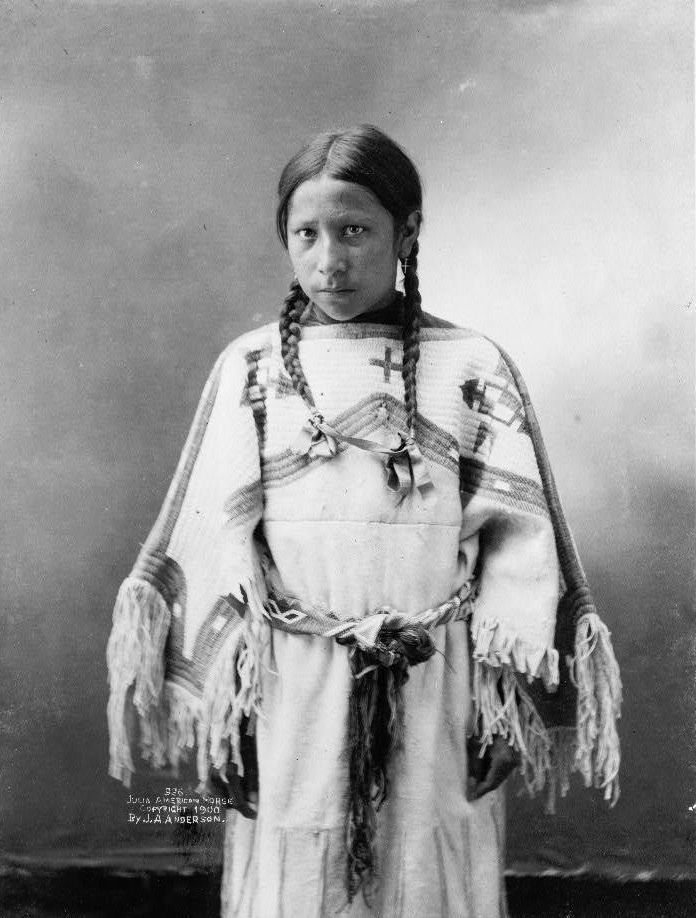
Julia American Horse
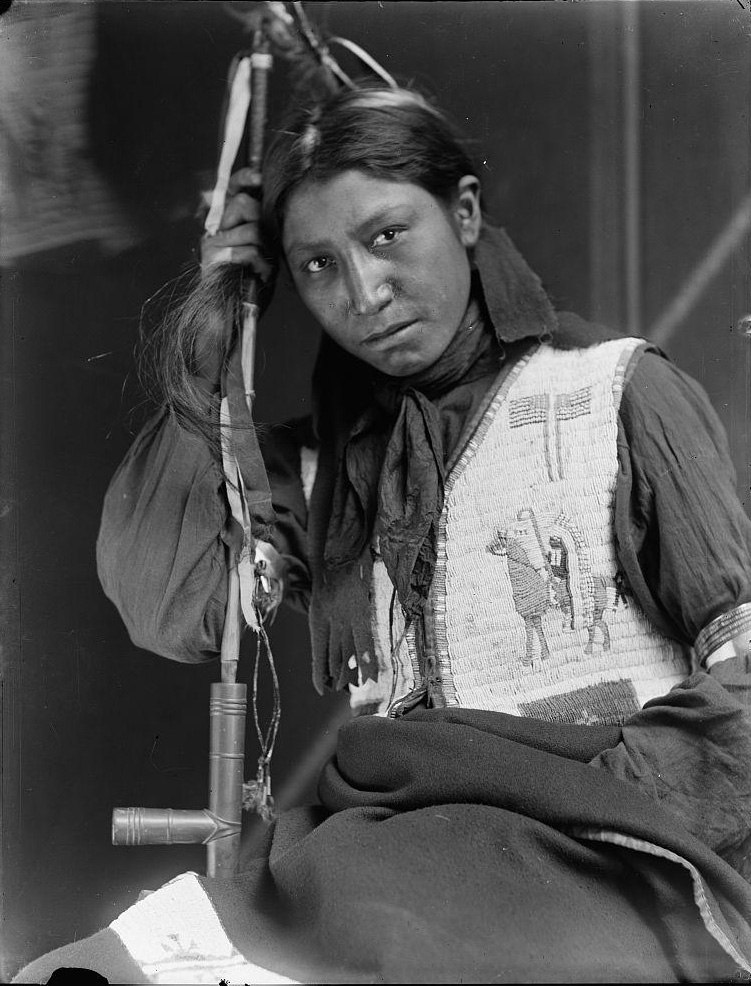
Charles American Horse
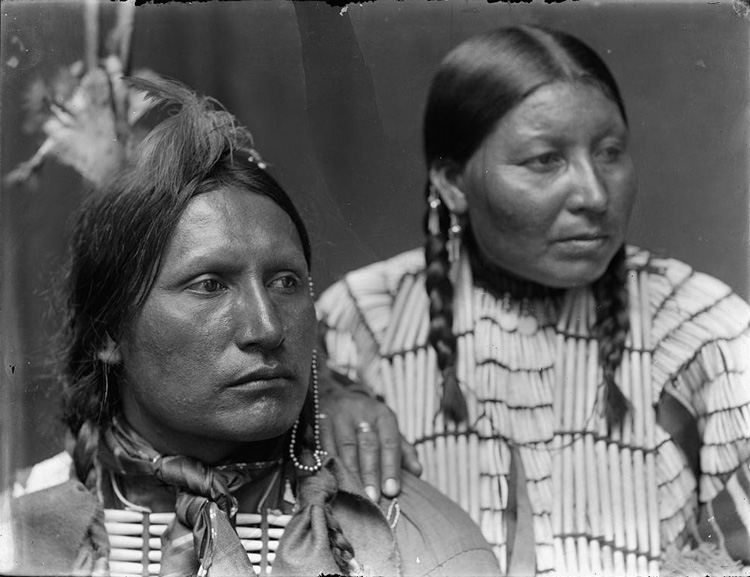
Samuel
American Horse & Wife
Now...
this is an interesting picture. I can't remember seeing
too many photos of a "squaw" dance. American Horse
should be the man standing left with the cane.
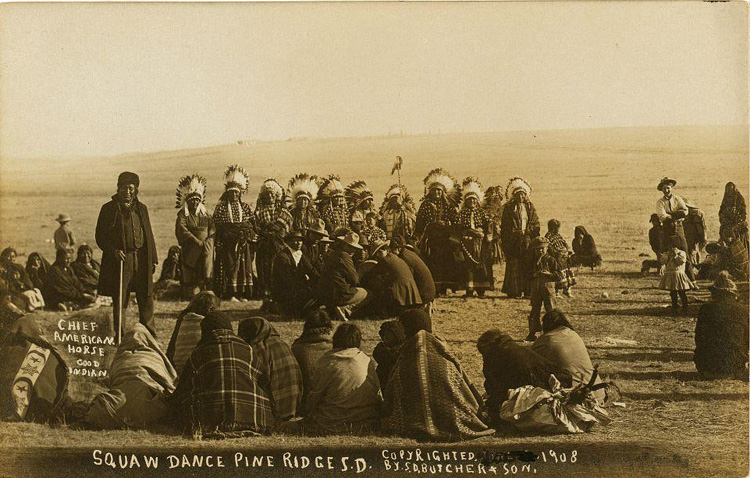
—
Dietmar Schulte-Möhring
Here
there are two of the latest pictures of American Horse:
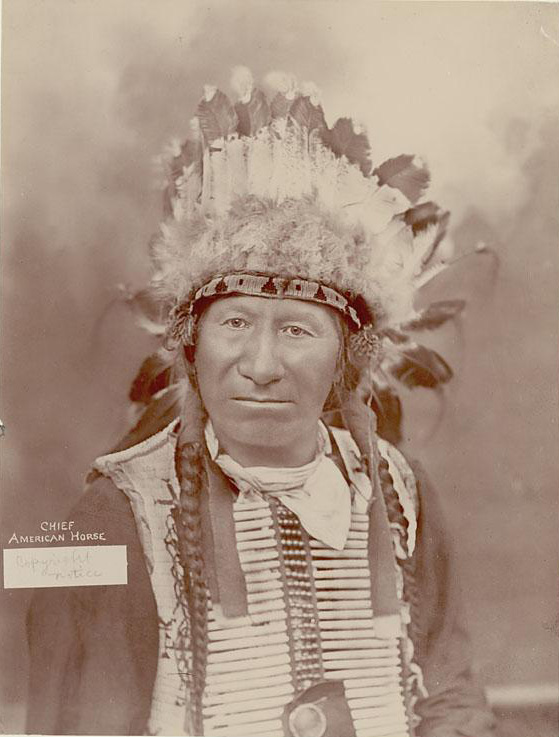
American Horse, December 1906
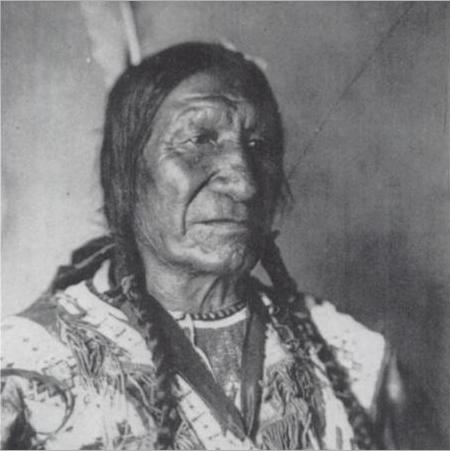
American Horse, 1907
—
jinlian
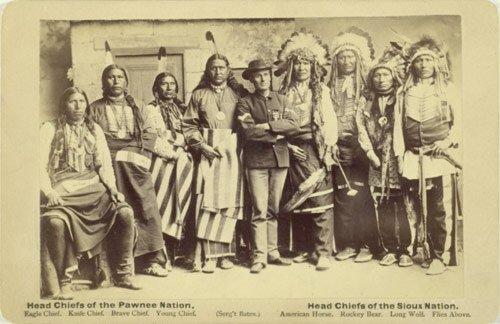
The
usual image from this session features Buffalo Bill in place
of Sgt. Bates. — Grahame
Wood

American
Horse joined Buffalo Bill's Wild West at least for the 1886
Staten Island tour (as attested by some pictures and newspaper
reports) but I don't know if he toured with Cody in later
years. I remember reading somewhere that one or two of American
Horse's sons joined the Wild West Show (one of them would
be the Native leading the "Sioux Ghost Dance"
in the 1894 Edison video) but can't remember where I got
this info right now. I'll check in the next days.
Update:
I found the reference about American Horse's son joining
the Wild West and featuring in the Sioux Dance video:
"Playing at Being Indian: Spectatorship and the Early Western"
"It
is possible that the Sioux dancer who gestures defiantly
at the camera in Edison's Sioux Ghost Dance is the Sioux
performer American Horse. A photograph of him taken by Gertrude
Kasebier around 1900-01 appears in Fleming and Luskey."
Then this son would be Samuel, the one
photographed with his wife in the picture posted by Dietmar.
— jinlian

Here
are two photos from the Beinecke Library:
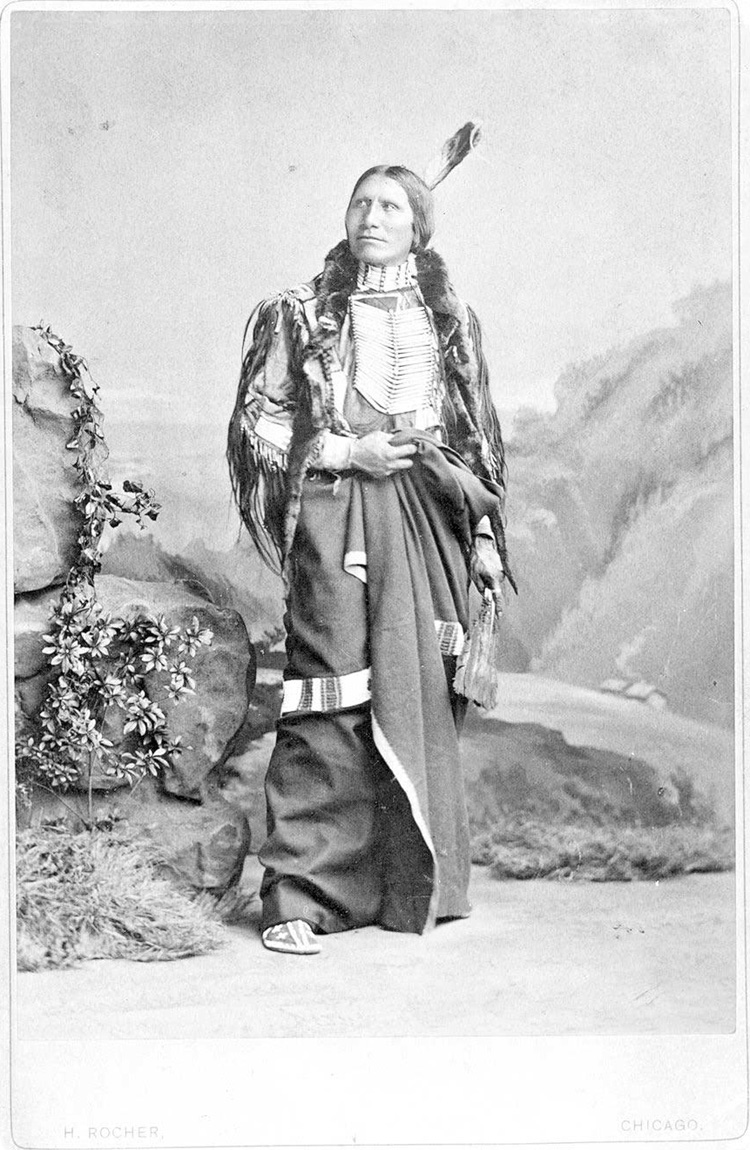
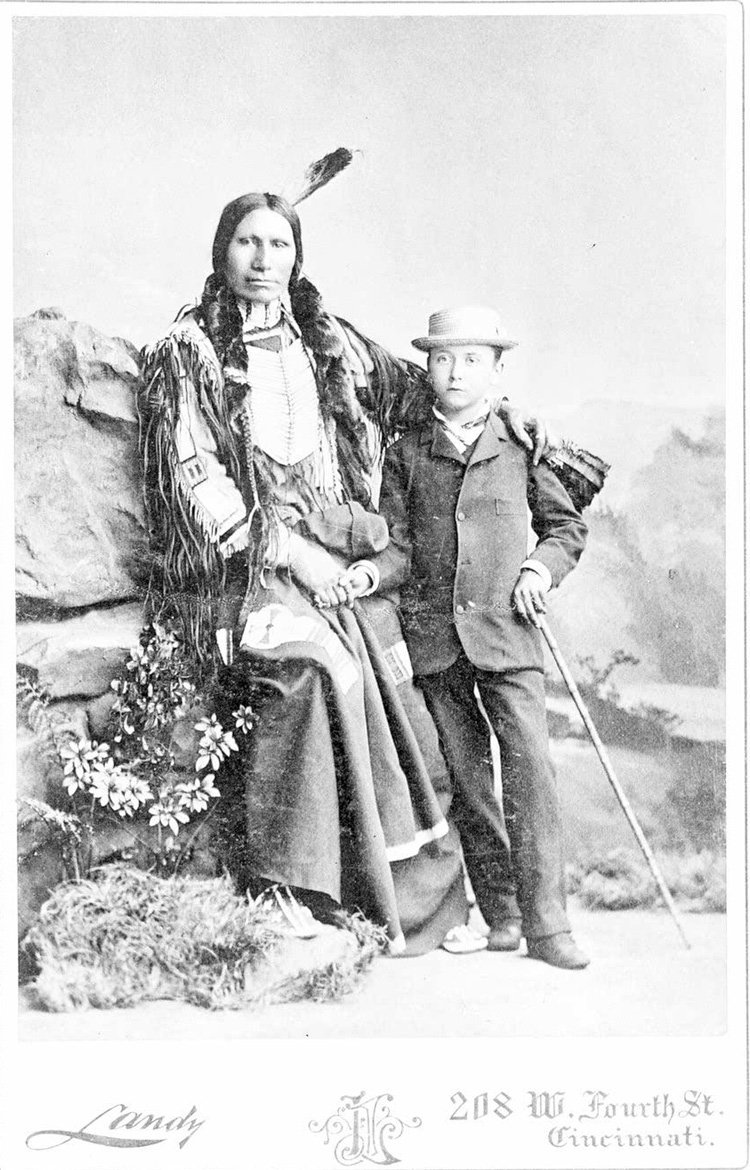
—
Dietmar Schulte-Möhring
I
think I got an idea about the identity of the boy after
reading "Cincinnati" on the bottom corner of the
picture. The New York Times on March 1st 1880,
reported the following news:
A
GRATEFUL DAKOTA CHIEF: QUAINT LETTER OF THANKS TO A CINCINNATI
SCHOOLBOY
From the Cincinnati Commercial, Feb. 28
"A
schoolboy in this city was moved recently by a letter published
in the Commercial to write to the Indian Chief American
Horse and send him some pictures. The great chief was pleased
and dictated to his young friend the following letter, in
which was inclosed a photograph of himself and wife and
daughter. . . . " (I think I mentioned this article
in one of my previous postings.)
The
letter reports only the boy's name, Edwin. Most probably,
American Horse visited him in 1880 while en route to Carlisle.
(The pictures of American Horse taken at Carlisle portray
him in more or less the same regalia he wears in Dietmar's
pictures, see below.)
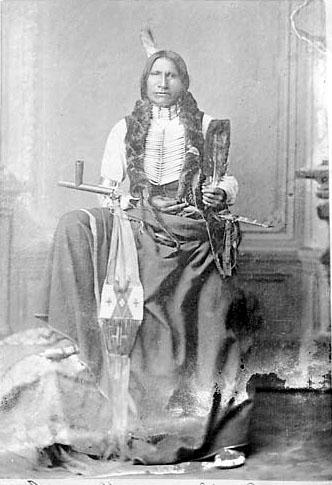
American
Horse, Carlisle, 1880
— jinlian
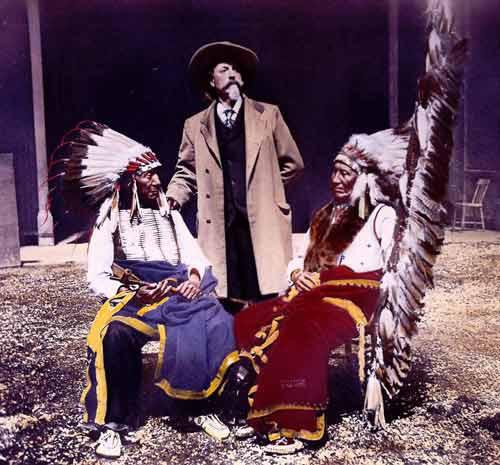
American
Horse was photographed with Cody and Red Cloud during the
1897 tour at Madison Square Gardens by David Barry. Red
Cloud and American Horse were east on business, however,
not with the show.
Is
the Godkin [photo below] the earliest American Horse portrait,
or was the 1877 delegation earlier? When was he working?
It can't have been much later than 77 or 78.
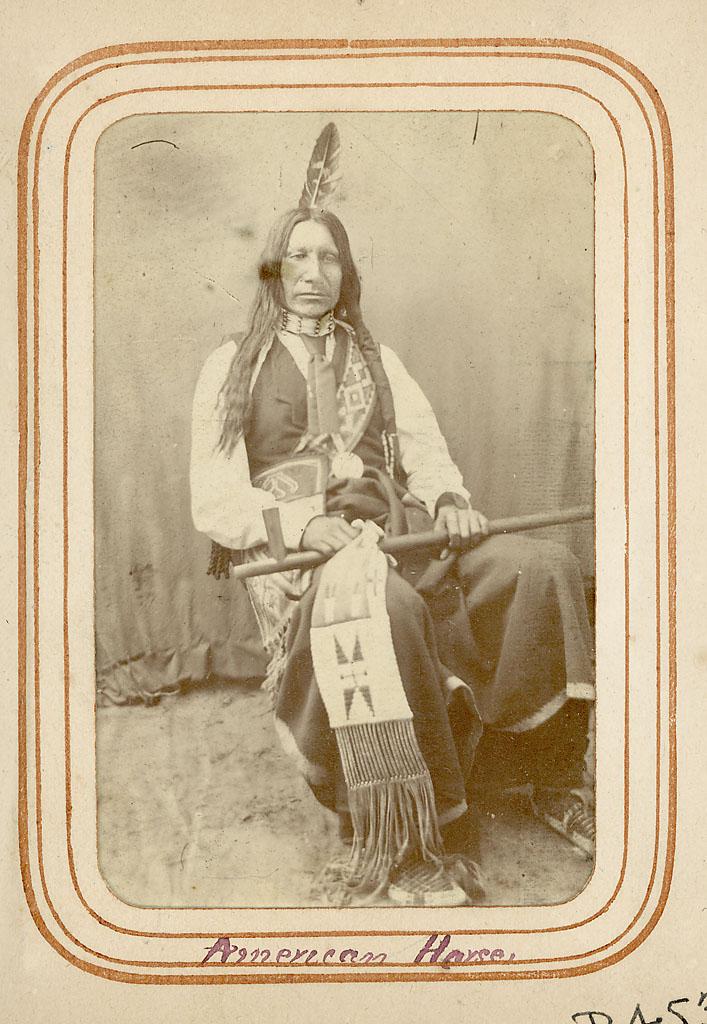
Here's
the rather famous American Horse-Red Cloud photo taken 1890-1,
I believe.
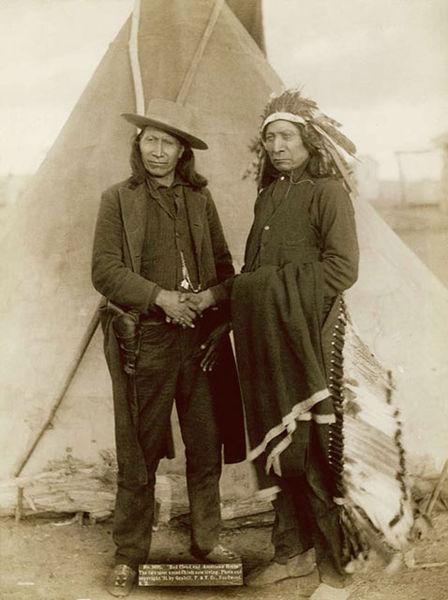
And
another from 1897:
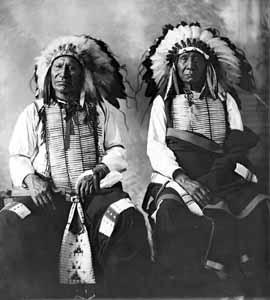
— Grahame Wood
I
don't have specific information about Godkin's activity,
but yes, in that portrait American Horse looks quite the
same he does in the 1877 delegation picture, at least if
you mean this one:
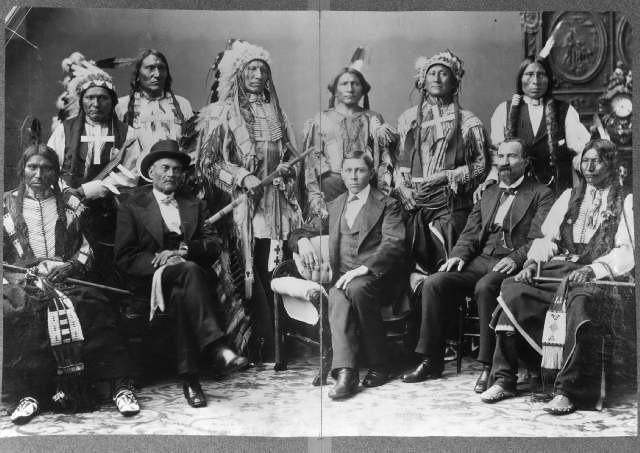
The last of the Red Cloud-American Horse pictures you've posted
was taken on January 1891 near Deadwood. —
jinlian

In
a rush but I wanted to say that the earliest photo including
American Horse, that I'm aware of, is the one taken during
the 1875 delegation visit to Washington, featuring leaders
from Red Cloud, Spotted Tail, and Cheyenne River agencies,
outside the Treasury Building. American Horse is seated
on the ground in the front row. —
Kingsley Bray
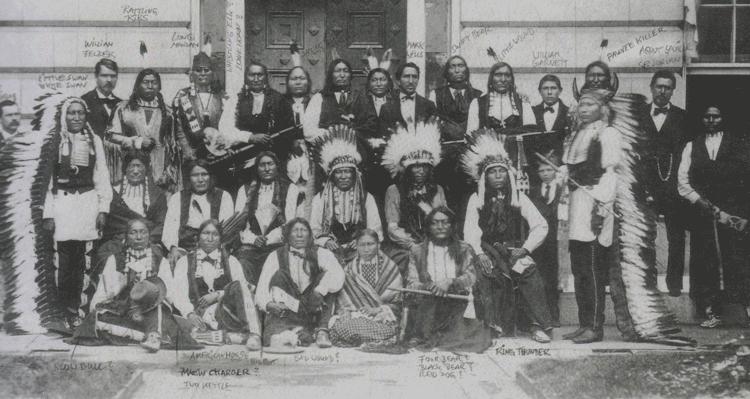
1875 delegation (American Horse sitting second
from left)
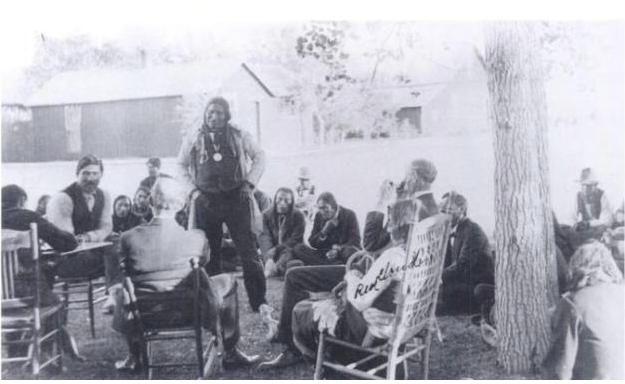
Tribal
council, Pine Ridge, 1903 - American Horse stands in the
middle; Red Cloud is sitting on the right.
A
less known picture of American Horse:
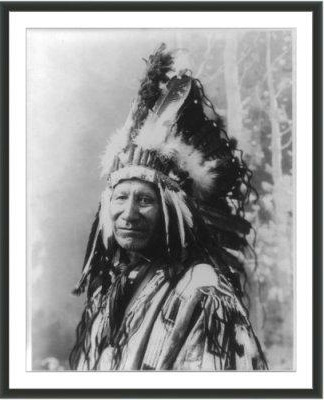
1900, from the Heyn and Matzen collection.
I've
finally managed to scan the picture of the 1888 Lakota delegation
to Washington. American Horse is marked with number 53;
at his left (n.54) is George
Sword. N. 39 and 40 are John
Grass and Gall.
N. 42 is Standing Rock agent McLaughlin.
In
the front row, first from left, R.H. Pratt. Second from
left is Commissioner for Indian Affairs J. Oberly.
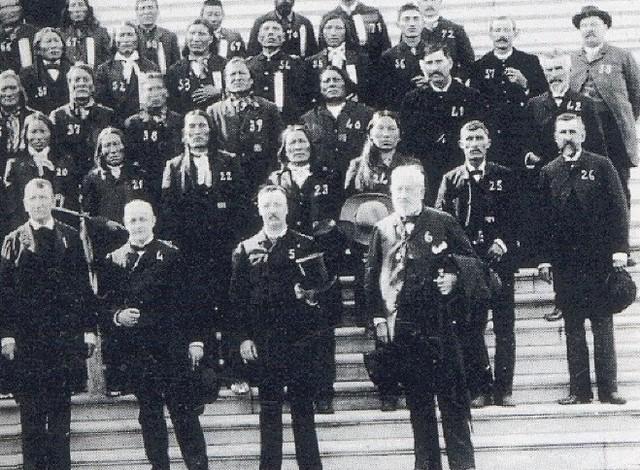
I've
been wondering about this point for a while, and recently
thought about another possible explaination to both the
American Horse - Cheyenne connection and the strange fact
of Sitting Bear's importance decreasing more and more along
the years. Could it be that American Horse's father (called
Sitting Bear in the winter count, but also American Horse
as it is stated in Red Cloud's autobiography- by the way,
Kingsley, where did you get the info that Sitting Bear was
also known as Three Bears?) at one point took a Cheyenne
wife and went to live with a Cheyenne band (a thing that
would also explain American Horse's statement to Sgt. Kenzie
as reported in the Ricker book "American Horse thinks
his sister is with the Southern Cheyennes"), thus disapperaring
from the Lakota camps? Also, is there a possibility that
the Sitting Bear mentioned in the documents was in fact
not American Horse's father, but his own grandfather (something
that would also explain the relevance given to this relative
by American Horse both in the Ricker and Eastman reports)?
Thanks
to the courtesy of the editor of the Annals of Wyoming,
I've got a copy of Mr. Belish's article, "American
Horse (Wasechun -Tashunka) The Man Who Killed Fetterman,"
and it does provide answers to at the least some of the
questions raised in the present discussion.
1.
About American Horse joining Buffalo Bill's Wild West: He
was with the show from April 1886 to February 1887 and visited
St.Louis, Dayton, Wheeling, Cumberland, Hagerstown, Frederick
City, Washington, Philadelphia, Staten Island.
2.
About the discussion on the 1888 land treaty: Belish suggests
that American Horse wasn't in fact neither pro nor against
the treaty, seeking rather to get more information about
every point of the agreement and then, when he was in fact
taken in by the idea of private property, he started speaking
against its fiscal implications. However, there's some disagreement
in American Horse's role in the 1888 commission talks (Hyde
and Olson gave opposite explanations, while Larson provided
a third theory which would conciliate the first two), but
at this point I'd need to read all the original U.S. Congress
documents about it.
About
American Horse's parentage: I'm thinking of another theory
regarding Sitting Bear but I'm waiting for other material
to corroborate it.
In
the meanwhile, here's another picture of American Horse
which hasn't been posted before:
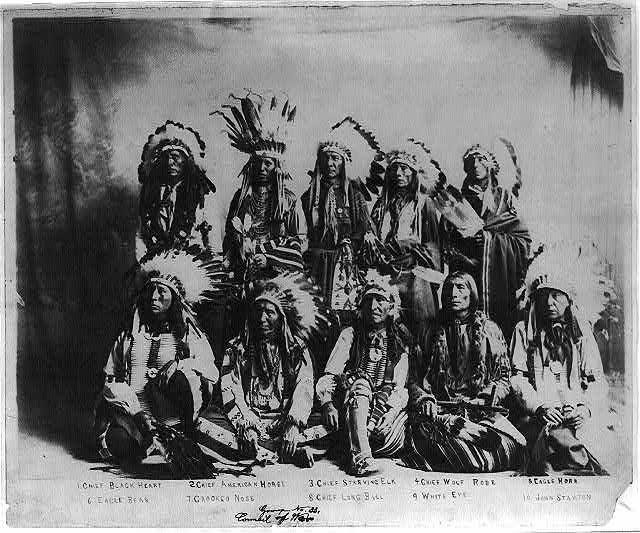
American
Horse is second from left in the sitting row. Unfortunately,
I wasn't able to retrieve any info about the year and location;
American Horse looks to be in his late fifties. —
jinlian

Found
another nice image of American Horse in my folder, its from
Stevenson El Reno.
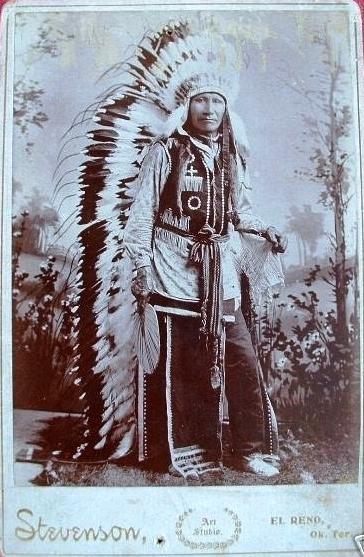
—
Henri/apsalooka
I'd
say it was taken when American Horse was touring with Cody
(1886-7).
Thanks
to a friend's courtesy, I've got another pic taken at the
1898 Trans-Mississippi in Omaha.
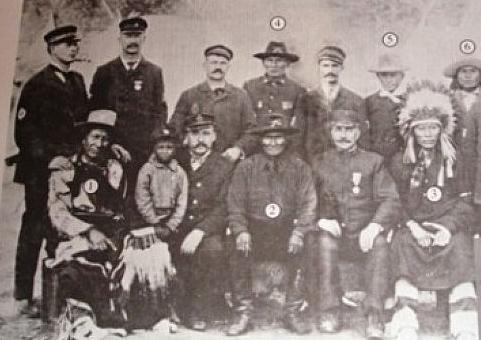
American
Horse, marked n.1 , sits in the first row (first from left);
fourth from left is Geronimo; wasn't able to identify the
last Indian in the first row (in the book he's identified
as "Two Moons, Cheyenne", but this identification
somehow doesn't sound right to me - was he in Omaha actually?).
Fourth and seventh in the standing row are Naiche
and Josh (Apache).
— jinlian

Isn't
it Hollow Horn Bear in the group photo
above? He was with American Horse in Washington. I've seen
another photo with him, American Horse, Geronimo, Buckskin
Charlie and Quanah Parker. . . .
Here
it is:
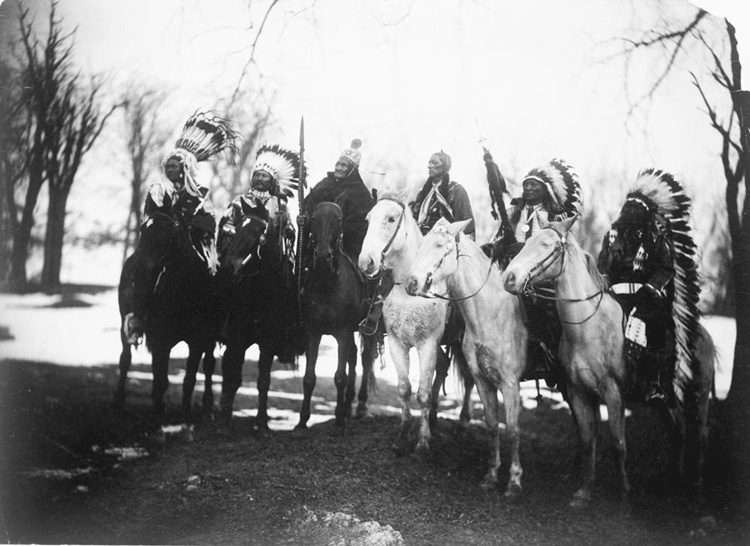 Left to right: Little Plume (Blackfeet),
Buckskin Charlie (Ute), Geronimo (Apache),
Quanah Parker (Comanche), Hollow Horn Bear
(Brule), American Horse (Oglala). —
Dietmar Schulte-Möhring
Left to right: Little Plume (Blackfeet),
Buckskin Charlie (Ute), Geronimo (Apache),
Quanah Parker (Comanche), Hollow Horn Bear
(Brule), American Horse (Oglala). —
Dietmar Schulte-Möhring

Here's
the Smithsonian Archives' record for the Trans-Mississippi
picture. American Horse should be the second from left.
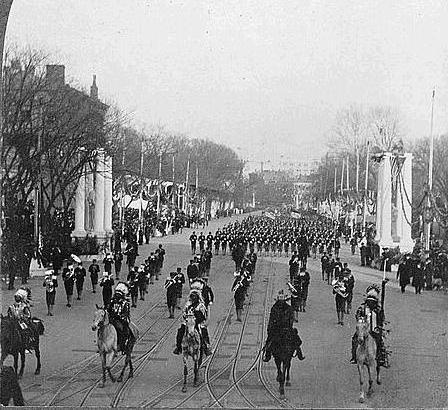
Speaking
of American Horse's distinctive features, Diane's mentioning
a "lazy eye" in the Red Wing thread has made me
think of a particular I've always wondered about, but, don't
know why, I've never mentioned in this discussion. In all
of American Horse's portraits is quite evident that one
of his eyes looks definitely smaller and somewhat less "lively"
than the other one.
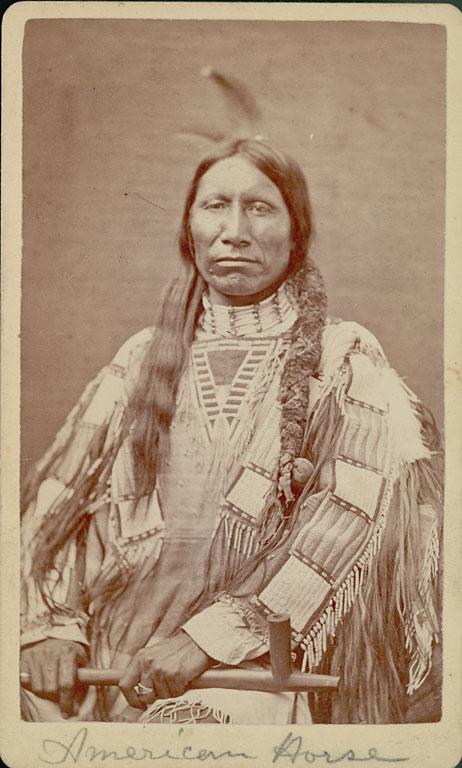
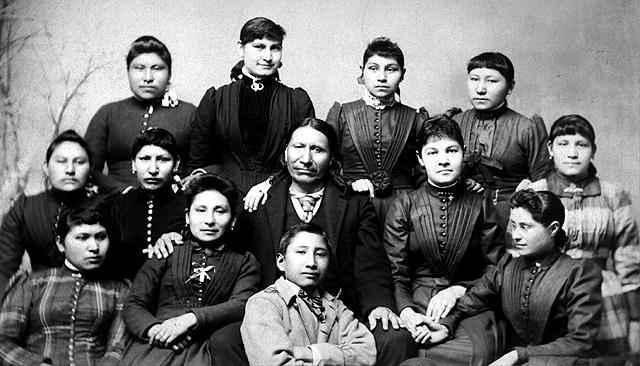
I
wondered if this was just a peculiar reaction to the camera
(I strongly doubt it, however) or some kind of pathology
(a little strabismus, maybe?). I've no medical background
to define it, anyway.
Found
another version of the photograph showing the Wild West
cast during the Staten Island tour (1886) I've posted:
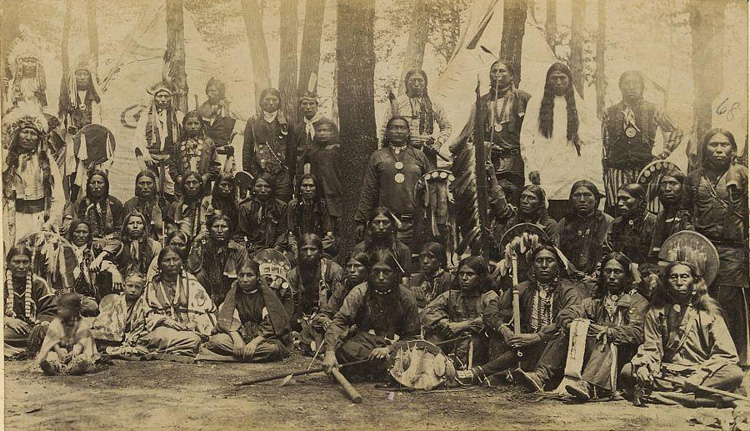
American
Horse is standing at the far left.
Still
from the image above, a close-up of American Horse:
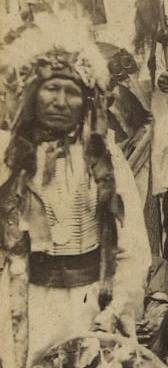
For
those who have not seen it:
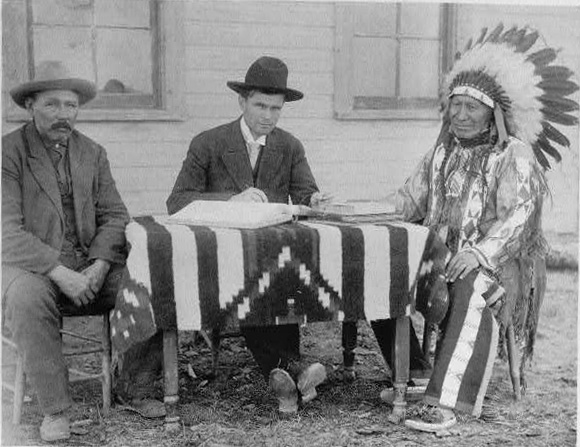
Record
says: U.S. allotting surveyor and interpreter making an
American citizen of Chief American Horse, Oglala Sioux,
1907. Left to right: Billy Garnett, Charles Ash Bates, American
Horse. — jinlian

The following publications contain information about American Horse:
Article: "War With the Sioux: Indian Fights and Fighters; Part III – End of the Sioux War" by Cyrus Townsend Brady • Pearson's Magazine • November 1904.
Article: "Redskins in the White House" by Jay F. Kay • Truth, honor, loyalty and justice were part of Chief Hollow Horn Bear's makeup. • Golden West • Vol. 1, No. 3 • March 1965.
Article: "American Horse (Wasechun-tashunka)" by Dan L. Thrapp • Encyclopedia of Frontier Biography • Spokane: The Arthur H. Clark Company • 1990 • Volume I, Page 22.
Back
to the Top